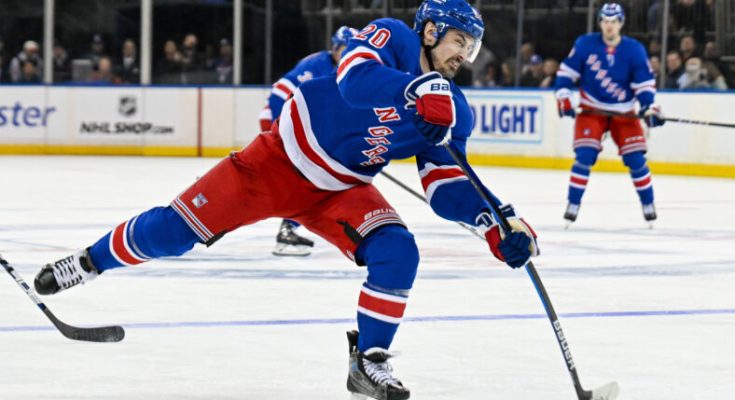Chris Kreider’s exit from the New York Rangers has triggered a ripple effect far beyond the locker room. It wasn’t just the end of an era—it was a turning point for a team that had leaned on his leadership, physical presence, and unwavering intensity for over a decade. And now, both Kreider and the teammates he left behind are navigating uncharted territory. Kreider, adjusting to life away from the only NHL team he had ever known, is confronting physical challenges and emotional transitions head-on, while those who skated alongside him are beginning to open up about their own struggles—injuries, unmet expectations, and the undeniable void his departure left behind.
Since joining the Rangers in 2012, Kreider was more than a power forward who crashed the net and scored big goals—he was an embodiment of the franchise’s identity. His departure, while not sudden, felt abrupt. It was one thing for fans to prepare for the inevitable; it was another for the locker room to feel the seismic shift. His leadership wasn’t loud, but it was consistent. He led by example on the ice, through effort and sacrifice. Whether it was killing penalties, tipping in pucks from the crease, or dropping gloves when a message had to be sent, Kreider was a cornerstone.
Now, post-Rangers life is proving to be a difficult adjustment. Sources close to Kreider say he’s still grappling with the emotional toll of leaving New York, the city he came to call home, and the organization that helped shape him. At 34, the wear and tear of a career spent grinding against top defensemen is catching up. He’s reportedly battling through lingering lower-body injuries that have affected his ability to train at full capacity this offseason. That comes as no surprise—Kreider’s playing style has always been physical, relentless, and built on explosive skating. But that same strength can become a vulnerability as the body ages.
The psychological weight of the transition may be even more daunting than the physical. Kreider was not just traded—he was separated from a brotherhood. The bond he shared with teammates like Mika Zibanejad, Adam Fox, and Igor Shesterkin was deep-rooted. Losing that daily camaraderie has reportedly taken an emotional toll, something often understated in the world of professional sports. The locker room isn’t just a workplace; it’s a support system. Rebuilding that in a new environment, no matter how professional, takes time.
Meanwhile, inside the Rangers’ locker room, his absence is being felt in more ways than one. Several teammates have privately admitted that the past few months have been difficult—not just because of Kreider’s departure, but due to their own physical and emotional battles. Some are nursing nagging injuries they pushed through last season, driven by the hope of a Stanley Cup run that never fully materialized. Others are dealing with the pressure of elevated expectations now that Kreider’s leadership is no longer a buffer. The team dynamic has changed, and in a sport where chemistry and trust can’t be quantified, that matters.
Kreider’s departure was also symbolic. It marked a final chapter in the Rangers’ long-standing rebuild, transitioning from a group with one foot in the past to a team entirely focused on the future. The younger generation is now fully in charge—players like Alexis Lafrenière, Kaapo Kakko, and K’Andre Miller are expected to carry the torch. But that transition isn’t always seamless. Growing pains are real, and without a veteran like Kreider around to stabilize the room, the process has become more volatile.
Several players have spoken candidly off the record about their frustrations. One skater admitted he played through a torn ligament in his wrist last season, unwilling to disclose the injury at the time for fear of losing ice time. Another confessed he felt the pressure to step into a leadership role he wasn’t ready for, admitting, “You can’t replace a guy like Kreids overnight.” These admissions, while rare in their honesty, paint a vivid picture of a team in emotional flux. Injuries and underperformance are part of the game, but when combined with a leadership vacuum, they create a more unstable foundation.
Adding to the complexity is the external pressure. Rangers fans are among the most passionate and demanding in hockey. They remember Kreider’s explosive playoff goals, his timely hits, and the passion he brought every night. They also remember how he represented the franchise with class, even when the team fell short. Now, the current group must forge a new identity without him, all while living up to the lofty expectations set during his tenure.
From a strategic standpoint, the Rangers’ front office insists they’re prepared for this transition. Management has pointed to a youth movement and a commitment to long-term sustainability. But replacing Kreider’s intangibles is far more difficult than filling a stat sheet. Hockey operations can’t simply measure locker room presence, accountability, and quiet leadership. And while the roster may be younger and more agile, it’s also less battle-tested. The result is a team in the midst of a delicate transformation—one that demands patience but operates in a market that offers little.
For Kreider, the path ahead remains unclear. While he hasn’t made any public statements regarding his future beyond hockey, those close to him suggest he’s contemplating what life after the NHL could look like. Coaching? Front office work? Player development? He’s said to be exploring all options, but for now, his focus is on recovery and reflection. It’s an unfamiliar position for a player who once relished every practice, every shift, and every opportunity to compete at the highest level.
In a recent sit-down interview, a former Rangers teammate revealed that Kreider’s voice is still in the back of everyone’s head. “Even when he’s not here, you still hear what he’d say in certain situations,” the player said. “That’s the kind of guy he was. His presence is still felt.” The comment speaks volumes about Kreider’s legacy—not as a superstar, but as a foundational piece whose impact lingers long after he’s left the building.
The bond between Kreider and New York was never transactional. He chose to stay in 2020 when many believed he’d be traded at the deadline. He signed a long-term deal because he believed in the rebuild, in the front office, and in the group around him. That level of belief forged trust with the fanbase. When he left, it wasn’t with bitterness—it was with gratitude and pride. And now, as both he and the team navigate unfamiliar territory, that foundation of respect remains intact.
What happens next will depend on several factors—how Kreider’s body responds to rest and treatment, how the Rangers adjust emotionally and tactically to his absence, and whether time brings clarity to a complex situation. One thing is certain: Chris Kreider’s story with the Rangers may have ended, but his influence is far from over. He was, and in many ways still is, a barometer for what the franchise represents—toughness, commitment, and character.
For the younger Rangers, the message is clear. The torch has been passed, but the standard remains. And for Kreider, the journey continues—not with the roar of Madison Square Garden behind him, but with the silent determination that defined his career from day one. Whether he returns in a different capacity or simply transitions to a new chapter in life, his legacy is etched into the fabric of Rangers history.
In the world of sports, not all goodbyes are clean, and not all transitions are smooth. But Chris Kreider’s evolution—like the man himself—is honest, raw, and ongoing. And for the Rangers, acknowledging that loss may be the first step in building something new.



